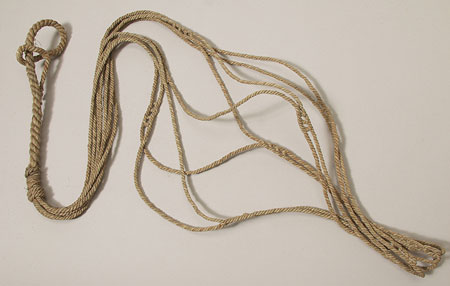Accession Number:
1931.66.24
Country:
Sudan
Region:
[Southern Sudan]
Cultural Group:
Nuer
Date Made:
By 1931
Materials:
Grass Fibre Plant
Process:
Twisted , Knotted
Dimensions:
L = 1296 mm, L top part = 300 mm, L bag = 533 mm, diam top rope = 12 mm, diam bag cords = 5 mm, w strands = 3 mm [RTS 9/7/2004].
Weight:
125.9 g
Other Owners:
Collected by Edward Evan Evans-Pritchard either in the early part of 1930 (probably February to April), or between February and June of 1931 [CM; RTS 9/7/2004].
Field Collector:
Edward Evan Evans-Pritchard
PRM Source:
Edward Evan Evans-Pritchard
Acquired:
Donated December 1931
Collected Date:
1930 - 1931
Description:
Sling made from several strands of light reddish and yellowish brown grass fibre (Pantone 467C) woven together at intervals to form a net bag which can be used to carry large vessels.
This consists of a thick rope at the top made from three fibre cords that have been twisted together and fastened with a knot at the end.
This rope has been bent into a loop at one end, with the loose end being passed around the rope's body and secured by weaving one of its constituent cords back through the loop on the other side.
This upper part serves as a carrying handle for the sling.
At its base, there are three cords wound around the body a number of times.
The first and last of these cords is made from triple strands twisted together; the middle cord is single stranded.
Below this section, the rope divides into 8 narrower cords, each similarly made of triple twisted strands.
These cords remain separate for the next 450 mm, at which point they are linked to a neighbouring cord by taking a single strand from each cord, twisting them together, then weaving them into the body of their neighbour.
This is done four times, creating a ladder-like pattern 35 mm long.
The cords then separate below for a further 220 mm before being fastened using this same technique to the cord on their other side, and then for a third time just above the base of the object.
By joining each cord briefly to its neighbour, first to the right and then to the left, a network bag is formed with large lozenge-shaped gaps in the sides and at the centre of the base.
The carrying sling is complete, with some fraying of the grass fibre strands.
It has a length of 1296 mm; the carrying loop is 300 mm long, while the netted bag section is 533 mm long.
The top rope has a diameter of 12 mm, which the narrower cords of the bag body have diameters of 5 mm, with each constituent strand being 3 mm wide.
The sling weighs 125.9 grams in total.
This object was collected by Edward Evan Evans-Pritchard during his first or second seasons of fieldwork amongst the Nuer, e.g.: in February to April 1930 or between February and June of 1931, in 'the dry season'. In the former, he spent around three and a half months in Leek territory at Yahnyang and Pakur on the Bahr el Ghazal, in Lou territory at Muot Dit, and at Adok, amongst the Dok Nuer. In the latter, he spent five and a half months at Nasir, on the Nyanding River, and at Yakwat on the Sobat River (see E.E. Evans-Pritchard, 1940, The Nuer , and the map of Evans-Pritchard's fieldwork in D.H. Johnson, "Evans-Pritchard, the Nuer, and the Sudan Political Service", African Affairs 81 no. 323, p. 233) (pers. comm. Chris Morton 2004).
This sling was used for carrying pots. For another Nuer sling, see For 1931.66.23; for a Dinka sling, see 1934.8.18.
Rachael Sparks 18/9/2005.
This object was collected by Edward Evan Evans-Pritchard during his first or second seasons of fieldwork amongst the Nuer, e.g.: in February to April 1930 or between February and June of 1931, in 'the dry season'. In the former, he spent around three and a half months in Leek territory at Yahnyang and Pakur on the Bahr el Ghazal, in Lou territory at Muot Dit, and at Adok, amongst the Dok Nuer. In the latter, he spent five and a half months at Nasir, on the Nyanding River, and at Yakwat on the Sobat River (see E.E. Evans-Pritchard, 1940, The Nuer , and the map of Evans-Pritchard's fieldwork in D.H. Johnson, "Evans-Pritchard, the Nuer, and the Sudan Political Service", African Affairs 81 no. 323, p. 233) (pers. comm. Chris Morton 2004).
This sling was used for carrying pots. For another Nuer sling, see For 1931.66.23; for a Dinka sling, see 1934.8.18.
Rachael Sparks 18/9/2005.
Primary Documentation:
Accession Book Entry
[IX, p.
16] 1931 [insert, in pencil] 66 [end insert]
E.
EVANS-PRITCHARD
, Esq.
Dec.
Specimens collected by himself in the EASTERN SUDAN, viz.
[...] [pencil insert, p.
18] 23-24 [end insert] - [One of] 2 Rope slings, for carrying pots, NUER.
Card Catalogue Entry - There is no further information on the tribes catalogue card [RTS 23/7/2004].
Old Pitt Rivers Museum label - Rope sling for carrying pots. NUER (NATH), E. SUDAN. Pres. by E. Evans-Pritchard 1931 [rectangular metal-edged tag, tied to object; RTS 9/7/2004].
Card Catalogue Entry - There is no further information on the tribes catalogue card [RTS 23/7/2004].
Old Pitt Rivers Museum label - Rope sling for carrying pots. NUER (NATH), E. SUDAN. Pres. by E. Evans-Pritchard 1931 [rectangular metal-edged tag, tied to object; RTS 9/7/2004].



